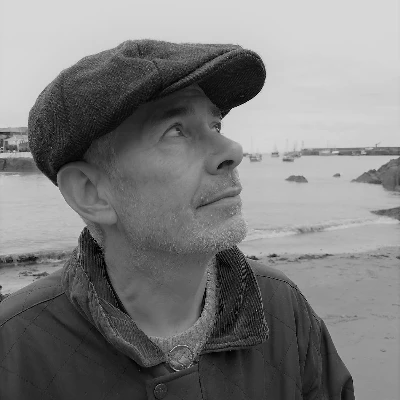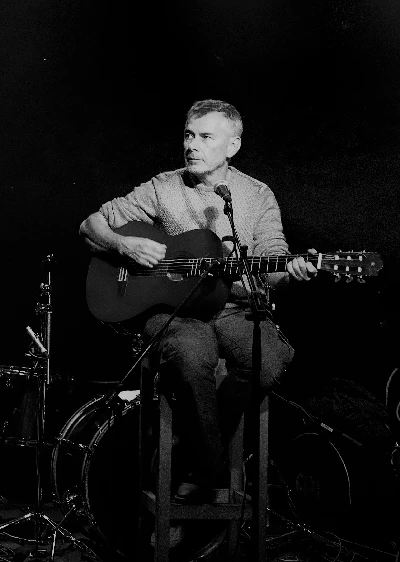published: 26 /
11 /
2022

In her series, 'A Life in Music', in which she speaks to Pennyblackmusic staff about how music has affected and influenced them, Cila Warncke talks to Steve Miles.
Article
A high-summer evening sky stretches behind Steve Miles, to his right, bookshelves and what looks like children’s artwork. Minutes into our conversation, he mentions that he has two young daughters, who are a big are part of the reason he’s here in North Somerset, a few minutes drive from his childhood home: “I wanted them to grow up somewhere nice.”
Miles is highly attuned to the constructive vibrations of environment, emotion, music. “Almost everyone I know prefers the music of their formative years,” he remarks. Hence his unspoken, yet plainly felt, responsibility as a parent, educator, musician and writer, to pay forward the joy and solace he finds in music. Here, Miles talks John Peel, punk, cycling and the intersection of music and mental health.
What musical culture(s) did you identify with most strongly as a young person?
I was a punk. There’s no escaping that. I try to write about a broader range [of music], so as not to appear fixated on my teenage years – because I’m not. But I feel young at heart.
What was your introduction to punk?
Like every boy of my age, I listened to John Peel. I had a tiny transistor radio and would put it under my pillow so my parents wouldn’t know I was still awake. I did that all through my teenage years, which was why I was always tired at school.
How has your relationship with music evolved?
One of the big changes has been the accessibility of music. From the age of about 13, the only place to hear the music I liked was the John Peel show. There was no Internet. It wasn’t on the TV. No other radio shows played it. There were two record stores in Bristol and I spent almost every lunch time in one or the other, looking at the records, saving to buy the next one. I’d read the ‘NME’ and ‘Melody Maker’, which were the only place to read about these bands, and buy records having only heard one song. The records, the writing, the [LP] covers mixed in your imagination in a way that no longer exists. I’m not sure it was better, but it was different. I invested more in music because it was so inaccessible. I’d buy a record a month, so had twelve new songs to listen to, which seems crazy.
What records did you buy?
Buzzcocks were the band I played the most. They were everything to me for a while. The Only Ones, who had two great records. Some bands I adored at the time I don’t rate so much now. Joy Division are still great, but I don’t think they’re as good now as I did then.
What are the biggest differences in your musical taste between ‘then’ and ‘now’?
Now I have so much access, I consume and enjoy music differently. It’s not hard-to-find gold. I have thousands of records, so I don’t listen to the same thing again and again. I also have less prejudice. There was an extreme sense in the punk era that you could only like the things that you should like, and hate everything else. Those two things: leaving behind the punk blinkers and the accessibility, means I now enjoy a vast range of music.
What attracts you to an artist/band?
I like music that has something to say, that pushes the boundaries in some way.
When did live music become a part of your life?
I went to gigs as much as I could in the punk era; sometimes I went to great lengths. Once I cycled ninety minutes to see Magazine in Bristol. When I came out, my bike had been trashed – the police were not sympathetic. Around the same time, I went to see The Only Ones, an amazing gig, but they didn’t come on stage till about 12. The problem was I’d arranged for my Dad to pick me up at 11:30. When I came out he was still there, but more angry than you can possibly imagine.
How did you become a musician?
You’re always in a band, if you like music, aren’t you? Even if it’s only in your head. I was in an imaginary band for a long time, and wrote bad songs on the guitar, occasionally. When I was about thirty, I bought a drum kit and did a spell drumming for Modesty Blaise. After a while they chucked me out, then I went another ten years [without playing] before bumping into an old school friend. He needed a drummer; then we recorded some of my songs and some of his songs. About ten years later, I met his best friend from school, Rob (Pursey), who asked me to record with him and his wife Amelia (Fletcher). We’re European Sun. [Read a European Sun interview here]
What’s a band you used to love that makes you cringe now?
I’ve never loved a band that makes me cringe now. I’ve always had too good of taste [smiles]. But there are lots of bands that didn’t turn out to be as good as I thought they were. One of the most exciting records of the post-punk era is the second album by Simple Minds, ‘Reel to Real Cacophony’. The songs are all short, all different, and nothing like any song you’ve heard before or since. Within two records, Simple Minds became a bland, shallow MOR stadium band, but that record is still new, it feels not of any time.
Who’s an artist you came to late but now love unreservedly?
When I was about fifteen, there was one black kid in our class at school who was from Zimbabwe. He lent me Jimi Hendrix’s ‘Electric Ladyland’. The British album cover had a lot of naked women – which Jimi didn’t want – and it put me off. It seemed anti-punk. Now, I’m a big fan of Hendrix.
What three artists would you see live, if you could time travel?
I would have loved to have watched, just once, Django Reinhardt, Stéphane Grappelli and the Hot Club de France. Django was a Gypsy whose had had been caught in a fire, he only had about two-and-a-half fingers, but he was literally the best virtuoso ever. There’s about two minutes on YouTube, which is all the footage of them in the world.
Also, Robert Johnson, the best and original blues singer. There’s no footage of him at all.
And I’d love to see the Velvets, because they are the best band in the world by a hundred miles. I could have seen them when they reformed, but that was hideous.
When and how did you get involved with Pennyblackmusic?
John [Clarkson] interviewed me in about 2010, when a CD by [my band] the Short Stories came out. Then there was a long gap when I didn’t do music because the twins were born. A couple of years ago, John heard European Sun’s first single and asked for another interview. Either he asked, or I did, if I could do one of those ‘10 Songs tRgat Made Me Love,,,’ features. Once you get me going I carry on; I wrote the two longest ‘10 Songs’ that ever ran.
How would you characterise Pennyblackmusic as a publication?
It’s hard for me to distinguish it from John Clarkson. His enthusiasm and commitment is second to none. Nobody writes for any reason other than passion. People review records and gigs they like and want to talk about. When you work on something you’re passionate about, sparks fly and the world is a great place.
How would you characterise your contribution?
The last few pieces I’ve done [the ‘In Dreams Begin Responsibilities’ series] have been about music and mental health. I’ve suffered from depression most of my life. A lot of people suffer with their mental health and are scared to talk about it. I want to write and to make it something people can talk about.
Why does music writing matter?
Music is a key part of every emotion I’ve ever felt and there is little that is more important in life than sharing your passions. If I haven’t listened to any music in a few days I struggle, like I’m running out of water. Even though I have thousands of songs to choose from, I don’t feel sated. If I were to talk about the real me, it wouldn’t be long before I talked about music. Rather like politics, there are things people might say that would make me walk away: if they liked Justin Bieber, for example.
Describe an image that encapsulates your life in music:
The record that changed my life in music was ‘Live 1969’ by the Velvets. It’s a double album recorded when Doug Yule was in the band, which is the version I prefer. It changed my whole conception of music. For one thing, it started my love of listening to [recorded] live music. That was the first time I realised that a recording was only one version, one incarnation of what a song could be. The LP has the most horrendous cover – a woman’s thighs. I read a lot of hardcore feminist literature as a teenager so I cut the album open and turned it inside out. There is a great picture of the Velvets on the inside – that’s the image.
Take 5…
1. A wedding song...
Louis Armstrong ‘What a Wonderful World’
2. A funeral song...
Write this down so I can point my family in the right direction: first, the theme from ‘Fistful of Dollars’, by Ennio Morricone. Second, ‘Kaliminkou Denkou’ by the Bulgarian State Radio and Television Female Vocal Choir from the album ‘Le Mystère des Voix Bulgares’.
3. The artist you’d most like to interview...
Doug Yule of the Velvet Underground. It makes me incredibly cross is that he is overlooked in their history. They were inducted into the Rock’n’Roll Hall of Fame and he wasn’t. It’s so wrong!
4. The artist you’d most like to be...
I’d still want to be myself, but I’d like to have Prince’s virtuosity – and Chris Isaak’s voice.
5. The song you never, never get tired of…
There are chart songs I heard in the car on the drive to school that still make me go, ‘ooh,’ when I hear them. So, ‘Lonely this Christmas’ by Mud, from when I was eleven. It cannot help but make me smile and sing along.
Play in YouTube:-
Picture Gallery:-
